What Mark Sanford did for love and Buenos Aires
 This evening in Buenos Aires, I danced at Confíteria La Ideal, the salon where Madonna was filmed performing tango in Evita. Like so much of Argentina’s capital, La Ideal with its marble stairs, Greek columns, beveled mirrors, and dark wood, is an architectural masterpiece but in a bit of disrepair. All of which adds to the romance for those of us who, like South Carolina Governor Mark Sanford, believe of Buenos Aires, “It’s a great city.”
This evening in Buenos Aires, I danced at Confíteria La Ideal, the salon where Madonna was filmed performing tango in Evita. Like so much of Argentina’s capital, La Ideal with its marble stairs, Greek columns, beveled mirrors, and dark wood, is an architectural masterpiece but in a bit of disrepair. All of which adds to the romance for those of us who, like South Carolina Governor Mark Sanford, believe of Buenos Aires, “It’s a great city.”
As I walked home down Corrientes, “the street that never sleeps,” passing the floodlit Obelisco, late-night bookstores, cafes, and theaters, I thought what a collateral reward Sanford’s dalliance with Maria Belen Chapur might be for the city of Buenos Aires. When I decided to come live here part-time three years ago, I was amazed at the misconceptions rampant among even my most educated friends. Was I going to learn Portuguese? How was my samba? People confuse it with Rio de Janeiro, which, um, is—still—in neighboring Brazil, where they do speak Portuguese and dance samba.
For the record, a brief primer: as Mark and Maria can tell you Argentina’s official tongue is 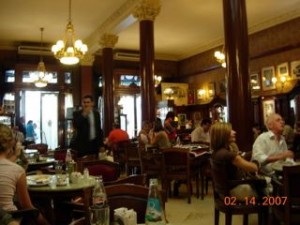 Castellano, Spain’s most widely spoken dialect. Let me also dispel the notion that Argentina is third world. It is a developed nation, rich in resources, most notably grazing land for its world-renowned grass-fed beef. Few people know that after World War II, Argentina was one of the world’s most wealthy countries. However, a bouncing back and forth between radical and military governments seems to have squandered much of that wealth. In contrast to heavily Amerindian countries like Peru and Bolivia, only about half of Argentina’s population has any indigenous blood. For better or worse, Buenos Aires is a very European city.
Castellano, Spain’s most widely spoken dialect. Let me also dispel the notion that Argentina is third world. It is a developed nation, rich in resources, most notably grazing land for its world-renowned grass-fed beef. Few people know that after World War II, Argentina was one of the world’s most wealthy countries. However, a bouncing back and forth between radical and military governments seems to have squandered much of that wealth. In contrast to heavily Amerindian countries like Peru and Bolivia, only about half of Argentina’s population has any indigenous blood. For better or worse, Buenos Aires is a very European city.
And it is incurably romantic. Its ornate, occasionally crumbling, facades are the legacy of Italian architects and French influence. Mark and Maria could have carried on their tryst in 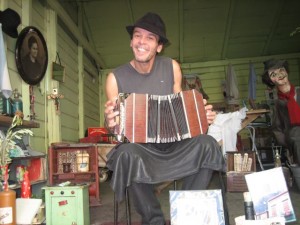 style. The city’s crown jewel, the Teatro Colon is closed for renovation, but another gem is the opulent and well-preserved Palace of Running Waters (Palacio de las Aguas Corrientes) on Riobamba Street. Inside, above the bland-as-water offices where Argentines pay their utility bills, is a darkly lit museum, the labyrinthine scene of a macabre crime in Tomás Eloy Martínez’s acclaimed 2004 novel, The Tango Singer. It’s perfect for lovers who wish to lose the downtown crowds—or paparazzi. The mounted pipe fittings and rows of toilet tanks and commodes are not as prosaic as they may sound—even Paris, the City of Light, has made its sewers a top tourist attraction (Le Musée des Egouts). And you can run your hands over artful chunks of the enamel-inlaid terra cotta building, also on display.
style. The city’s crown jewel, the Teatro Colon is closed for renovation, but another gem is the opulent and well-preserved Palace of Running Waters (Palacio de las Aguas Corrientes) on Riobamba Street. Inside, above the bland-as-water offices where Argentines pay their utility bills, is a darkly lit museum, the labyrinthine scene of a macabre crime in Tomás Eloy Martínez’s acclaimed 2004 novel, The Tango Singer. It’s perfect for lovers who wish to lose the downtown crowds—or paparazzi. The mounted pipe fittings and rows of toilet tanks and commodes are not as prosaic as they may sound—even Paris, the City of Light, has made its sewers a top tourist attraction (Le Musée des Egouts). And you can run your hands over artful chunks of the enamel-inlaid terra cotta building, also on display.
The Palacio Barolo on Avenida de Mayo, a sumptuous design of Italian architect Mario Palanti who was inspired by Dante’s Divine Comedy, also holds a spectacular venue on its rooftop. 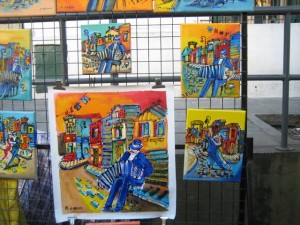 Guided day tours of this literary archetype are available (check online). But one night a month may find me climbing amid the rose marble and shiny brass from purgatory (floors 1 to 14) to heaven (floors 15 to 22) where there is a rooftop cupola. On the roof, every first Tuesday, Tango Moda clothier hosts an open house party. A defunct lighthouse, from which, on a clear day you can see to Montevideo, also graces the roof. Mark and Maria could have easily blended in with the international set of shoppers and dancers, whom fashionista and tanguero, Jorge Arias, fishes out of the dance halls for this event. Drop by—tell him I sent you.
Guided day tours of this literary archetype are available (check online). But one night a month may find me climbing amid the rose marble and shiny brass from purgatory (floors 1 to 14) to heaven (floors 15 to 22) where there is a rooftop cupola. On the roof, every first Tuesday, Tango Moda clothier hosts an open house party. A defunct lighthouse, from which, on a clear day you can see to Montevideo, also graces the roof. Mark and Maria could have easily blended in with the international set of shoppers and dancers, whom fashionista and tanguero, Jorge Arias, fishes out of the dance halls for this event. Drop by—tell him I sent you.
It comes as a surprise to many that Buenos Aires is more Italian than anything else, a result of the waves of European immigrants who landed here in the early 1900s. For many it adds to the city’s romance. The mellifluous dialect, lubricated with many Neapolitan “sh” and “jh” sounds, includes numerous Italo-cisms (Che! Hey! Dale! Let’s go!; and chau, meaning ciao) and an Italianate argot, called Lunfardo (heard frequently in tango lyrics). Porteños, as residents of this port city call themselves, also have a repertoire of hand signals—straight from the old country. They think that their pizza and pasta is better than that of Italy’s. When I eat at such venerable places as El Cuartito on Talcahuano Street or at Pizza a la Parrilla at Scalabrini Ortiz and Loyola, forgive me, Grandparents, I tend to agree.
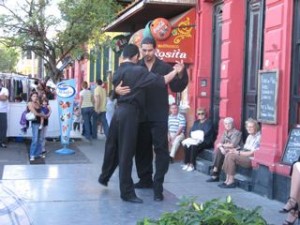 Buenos Aires is at least as romantic as Paris. Several times a week, I stroll some two miles along Libertador, the city’s Champs Elysées, passing sidewalk cafes, plazas, and monuments. On or just off this broad axis are six museums that are free or cheap, never crowded, and full of fine art. The most romantic of them are the Museo Nacional de Bellas Artes; the exquisite Museo Nacional de Arte Decorativo, a neo-classical French mansion with portico, Corinthian columns, and the Croque Madame café; and the pint-size Evita Museo, serving up the myth and magic of one immortal Eva Peron. My stroll ends at a park, Tres de Febrero, with a rose garden, pergola, lakes, stone benches, and sculptures to make the Bois de Boulogne look pale.
Buenos Aires is at least as romantic as Paris. Several times a week, I stroll some two miles along Libertador, the city’s Champs Elysées, passing sidewalk cafes, plazas, and monuments. On or just off this broad axis are six museums that are free or cheap, never crowded, and full of fine art. The most romantic of them are the Museo Nacional de Bellas Artes; the exquisite Museo Nacional de Arte Decorativo, a neo-classical French mansion with portico, Corinthian columns, and the Croque Madame café; and the pint-size Evita Museo, serving up the myth and magic of one immortal Eva Peron. My stroll ends at a park, Tres de Febrero, with a rose garden, pergola, lakes, stone benches, and sculptures to make the Bois de Boulogne look pale.
Just like my times in Paris, every day here I come upon young couples in unabashed lip-lock, completely oblivious to passers-by, in the park, subway, or leaning against the broad-canopied deciduous trees that prettify streets. On a certain night in a certain doorway in the hip barrio of Palermo, you might find me discreetly giving a good night kiss to my favorite tango partner. 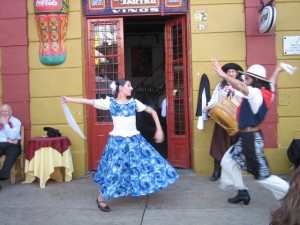 However, for me, a writer always living on the edge, the real siren call of Buenos Aires is how it evokes what Paris of the 1920s, with its Lost Generation, might have been like.
However, for me, a writer always living on the edge, the real siren call of Buenos Aires is how it evokes what Paris of the 1920s, with its Lost Generation, might have been like.
I felt affirmed in this sentiment when I read The Tango Singer. The narrator, tooling around the centenary market in San Telmo, the oldest part of the city, says “In no other place in the world have things kept the flavor they’d had in the past as much as in this Buenos Aires . . .” The youth who flock to San Telmo and Palermo come as much for the low cost of living as for the enduring artistic, intellectual, and creative juice that is dried up or priced out of their reach in places like Paris, London, Rome, Madrid—and even Prague now. Francis Ford Coppola, a frequent denizen, has shot film in the city as have foreign TV production companies.
I rhapsodized on all this during a recent visit to the café at the back of Ateneo, a multi-tiered Greek theater turned bookstore on Santa Fe Street (if bookstores were futures, this city would have an economy of pure gold). Patrons were curled up on a couch perusing books they could return to a shelf without having to purchase them (this sort of kindness to consumers is widespread in a country that suffered a severe financial crisis in 2001 when, among other things, the peso lost parity with the dollar). Couples huddled conspiratorially over espresso and pastries. A solitary musician coaxed American jazz from a chipped upright piano. He had me lip-syncing and longing to linger with a glass of sherry and a copy of Jorge Luis Borges’ Labyrinths. The country’s most revered author borders on impenetrable metaphysics but he wrote passionately straightforward in a poem, Fundacion mitica de Buenos Aires, about his beloved city, “For me it is a fairytale that Buenos Aires had a beginning/I judge it as eternal as water and air.”
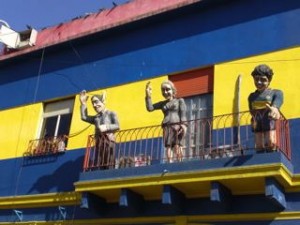 How could the birthplace of tango, whose music Borges loved, not be romantic? The country’s most famous folk dance has been enjoying a renaissance, a long overdue comeback. Tango was suppressed during the last dictatorship, because public meetings were forbidden. For this reason, most baby boomers didn’t learn the dance of their parents and grandparents. Democracy was restored only in 1983, and now the city boasts more than a hundred milongas, the venues where tango and only tango is danced. Some are known by mere word of mouth and it’s a joy to discover them trying to hide from us foreigners, who are desperate for the dance’s organic roots, in little sports clubs of the outlying barrios like Villa Urquiza. But there are tango dance halls all around the city heating up as early as two in the afternoon, some not cooling down until six in the morning.
How could the birthplace of tango, whose music Borges loved, not be romantic? The country’s most famous folk dance has been enjoying a renaissance, a long overdue comeback. Tango was suppressed during the last dictatorship, because public meetings were forbidden. For this reason, most baby boomers didn’t learn the dance of their parents and grandparents. Democracy was restored only in 1983, and now the city boasts more than a hundred milongas, the venues where tango and only tango is danced. Some are known by mere word of mouth and it’s a joy to discover them trying to hide from us foreigners, who are desperate for the dance’s organic roots, in little sports clubs of the outlying barrios like Villa Urquiza. But there are tango dance halls all around the city heating up as early as two in the afternoon, some not cooling down until six in the morning.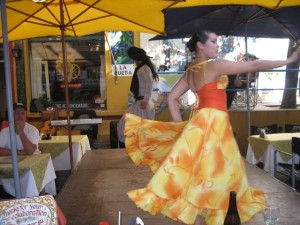
People ask me, did Mark and Maria tango? I doubt it, but too bad. The milonga, with its very traditional codigos or etiquette, offers a splendid form of communication that might have spared them the embarrassment of those now public emails. In a milonga, men and women agree to dance with each other wordlessly, through a nod of the head or lock of the eyes, called a cabeceo. They implicitly agree to dance a whole tanda, or set of three or four like-themed songs. Between those songs, like all the other dancing couples, they are advised to stand facing each other for about thirty seconds and engage in charla, or chat. Eso! Nobody but the two parties involved ever need know if you’re telling your partner you wish she/he were a better dancer or you like the curve of her/his hips.
At La Ideal this evening, I danced with four different men, two of whom kept up an entertaining competition for my attention, each whispering textbook endearments and little ironic putdowns of each other. One of them wanted me to meet him at a secret haunt, (See Below**) Bistro, tucked away on (See Below**), a narrow pasaje, or passage, right out of Paris’s 16th arrondissement. I didn’t tell him I have met my good friend, Leonardo, at the tiny, intimate cafe many times. Or that throughout the city, amid the architectural disasters of the 1950s and 1960s, there are these lovely lamp-lit cobblestone pasajes.
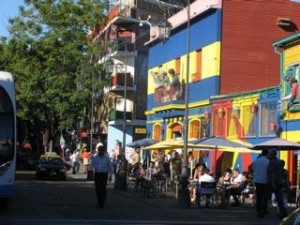 I left for home without either of the suitors, having gotten exactly what I had come for—the dance, its ineffable embrace, the Zenlike satisfaction of stepping in time with another person to music that has endured seven and eight decades. Beyond romance, the whole empanada—the Obelisco that several years ago was sheathed in a pink condom (for Safe Sex Day); the macho “entertainment” at milongas; the city’s nightlife, its leafy day light; and even the broken sidewalk tiles and constant flow of traffic—is all very exciting. Perhaps in time Mark and Maria will share some of their secret haunts in this city that is sure to now be—correctly located—on any romantic’s map.
I left for home without either of the suitors, having gotten exactly what I had come for—the dance, its ineffable embrace, the Zenlike satisfaction of stepping in time with another person to music that has endured seven and eight decades. Beyond romance, the whole empanada—the Obelisco that several years ago was sheathed in a pink condom (for Safe Sex Day); the macho “entertainment” at milongas; the city’s nightlife, its leafy day light; and even the broken sidewalk tiles and constant flow of traffic—is all very exciting. Perhaps in time Mark and Maria will share some of their secret haunts in this city that is sure to now be—correctly located—on any romantic’s map.
**Note: — name of Bistro is withheld upon request of my friend Leonardo. But if you write me an email [ocaramia@mac.net], I will share helpful coordinates.